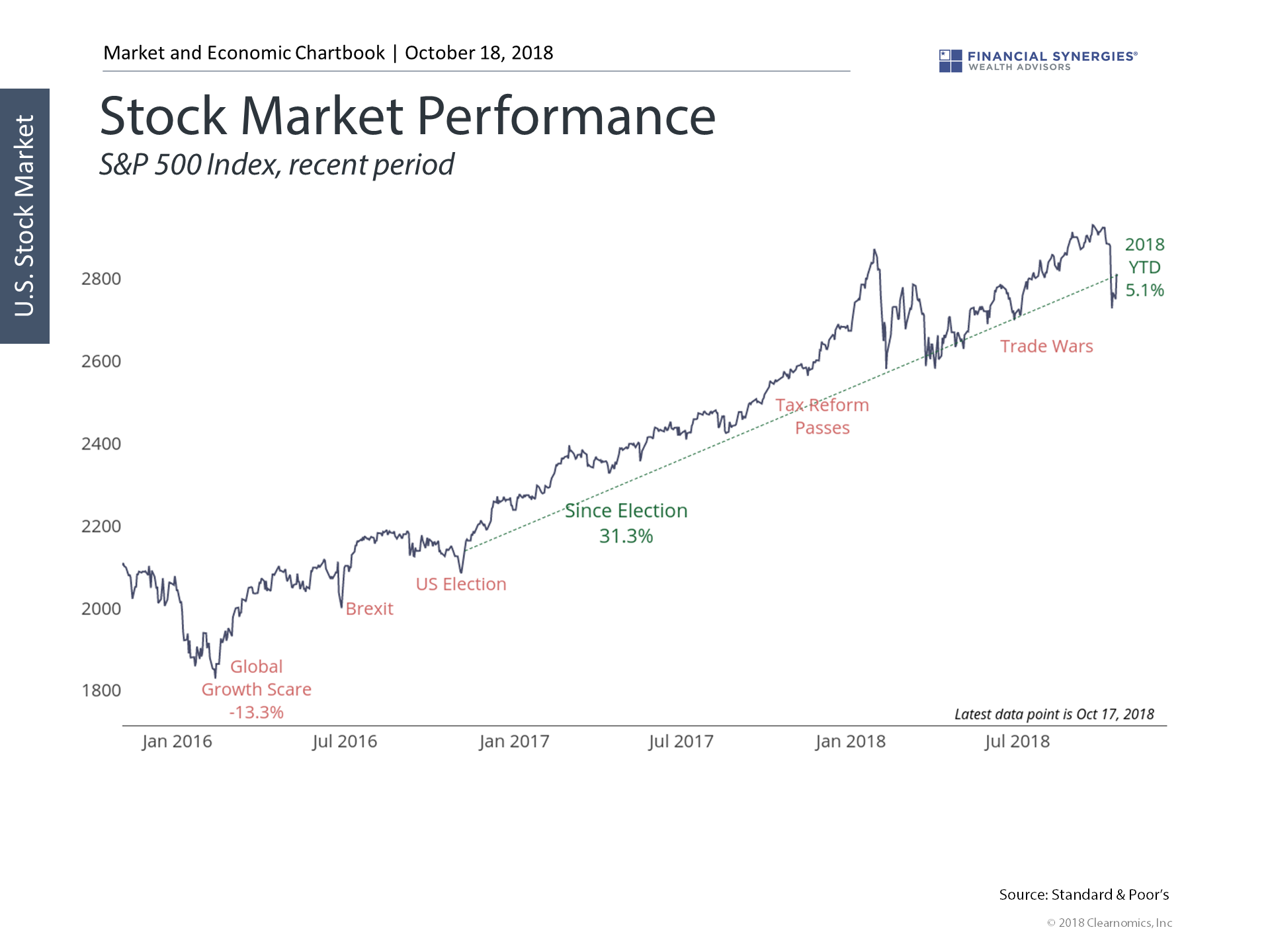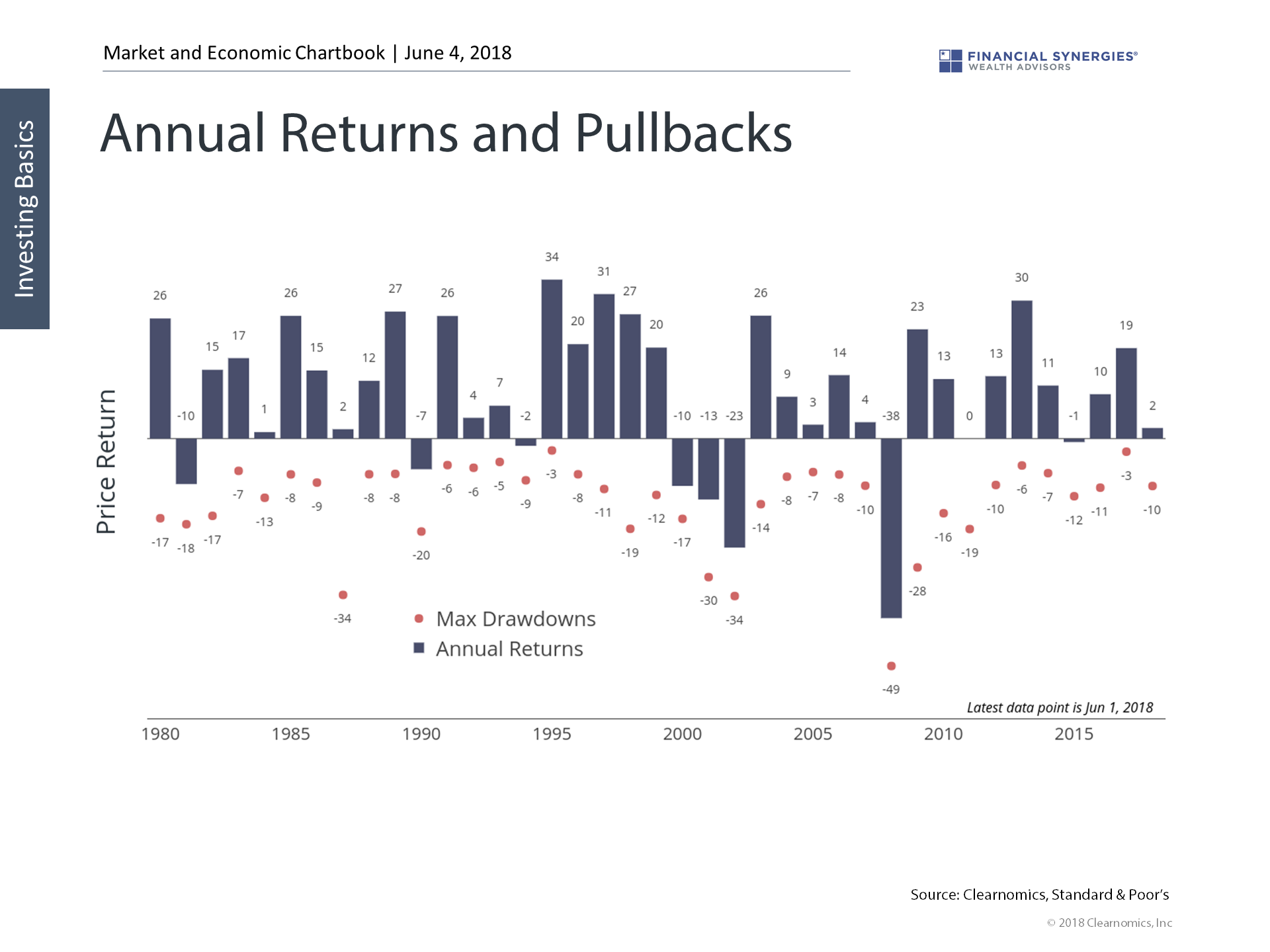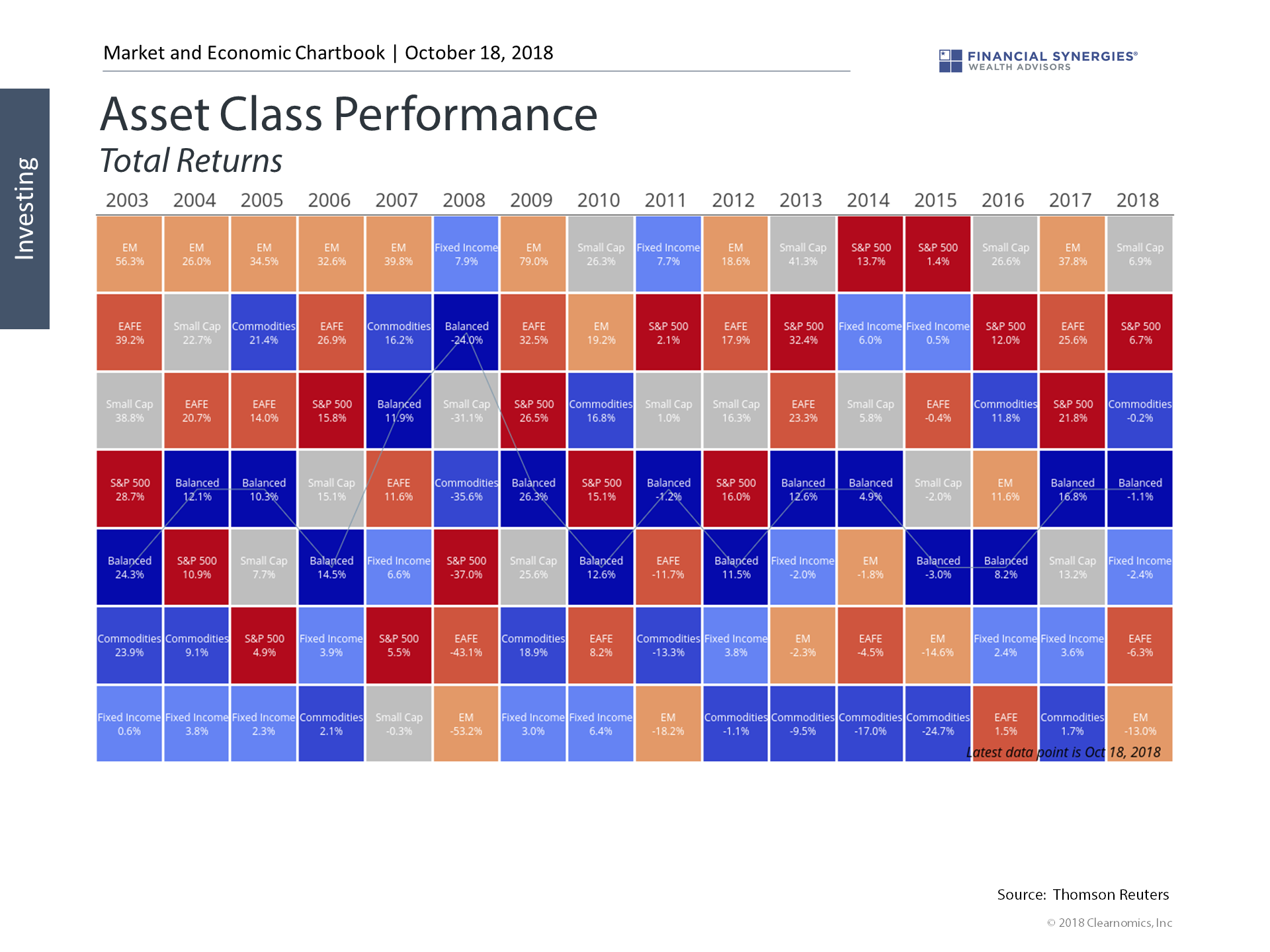A great quote on maintaining composure in volatile situations is often attributed to the boxer Mike Tyson: “everyone has a plan until they get punched in the face.” With the S&P 500 tumbling -4.1% last week, many investors may feel a bit roughed up. Volatility increased with swings in both directions: stocks fell -5.3% over two days, representing the worst decline since February, before rebounding 1.4% on Friday, the best day since April.
There are a number of factors driving this volatility including trade wars, Fed rate hikes, fears that earnings growth has peaked, a sector rotation, and more. And while it’s natural to wonder where the market will go from here, it’s more important not to lose sight of your financial plan.
After all, the beauty of long-term investing is that the specifics of any market episode matter less than maintaining a good overall course in a balanced portfolio. Thus, there are two important takeaways from this latest market episode. First, stock market volatility is not only normal – it’s healthy. Short-term declines of 5% are par for the course when investing in stocks and are not necessarily cause for alarm. If the economy and corporate fundamentals remain healthy, stocks will do well in the long run.
Second, there are always reasons to be concerned, which we often refer to as the “wall of worry.” Over the past nine years, the wall has consisted of: fears of a double-dip recession, government shutdowns, fiscal cliffs, deflation, central bank distortions, collapsing oil prices, Grexit, Brexit, Russia, China, trade wars, tech stocks, and many more. The goal of any long-term investor with a financial plan isn’t to swerve in and out of markets to avoid a few potholes. Instead, it’s to maintain a portfolio that can withstand these bumps.
1. Markets stumbled last week
 The U.S. market declined by about -4% last week, the biggest bout of volatility since February. In general, the market has been climbing the wall of worry all year, and certainly since 2016. Strong corporate earnings growth has helped, as have tax cuts and a healthy economic backdrop.
The U.S. market declined by about -4% last week, the biggest bout of volatility since February. In general, the market has been climbing the wall of worry all year, and certainly since 2016. Strong corporate earnings growth has helped, as have tax cuts and a healthy economic backdrop.
While the recent market decline may appear large in the context of recent market calm, it’s important to keep in mind that the stock market is inherently volatile, as seen in the next chart.
2. This level of volatility is normal and healthy

Battling our own natural tendencies is one of the challenges of investing. This is especially true today since the relative market calm of the past two years may have left some investors unprepared for rising volatility.
This chart shows each year’s stock market return (bars) compared to the worst pullback during the year (dots). In 2017, the worst pullback was less than 3%, the lowest since 1995. Such a low level of volatility is highly unusual since almost every single year experiences a market pullback of at least 5%. The average intra-year decline since World War II comes in at -13.4%. Thus, this year’s largest decline of -10% is fairly typical.
What’s more important is the fact that most years end in positive territory even if they face significant declines intra-year. This is why investors can often be their own worst enemies since their natural tendency may be to sell when things are already at their worst. Thus, it’s important to focus on long-term trends rather than daily market moves.
3. A balanced portfolio is still the best way to navigate volatility

Rather than worry about each individual market move, we construct balanced portfolios that weather market volatility. The periodic table above highlights the importance of diversification and taking a long-term view. The balanced portfolio approximates a 60/40 stock/bond allocation. It’s never the best (or worst) performer – but this is by design. Instead, it’s a steady performer, always in the middle of the pack through good markets and bad. And hopefully provides some peace of mind.
This is also evidence that market timing is virtually impossible. The best performer one year can easily be the worst in the next. Take emerging markets – it had a historic stretch of outperformance from 2003 to 2007, before plummeting over 50% in 2008. Commodities had a terrible run over the past several years, but outperformed in 2016. A balanced portfolio naturally smooths over these wide variations.
Maintaining investment discipline, sticking with a balanced portfolio, and focusing on long-term trends are still the best ways to maintain composure in volatile markets.
Maintaining Composure in Choppy Markets
A great quote on maintaining composure in volatile situations is often attributed to the boxer Mike Tyson: “everyone has a plan until they get punched in the face.” With the S&P 500 tumbling -4.1% last week, many investors may feel a bit roughed up. Volatility increased with swings in both directions: stocks fell -5.3% over two days, representing the worst decline since February, before rebounding 1.4% on Friday, the best day since April.
There are a number of factors driving this volatility including trade wars, Fed rate hikes, fears that earnings growth has peaked, a sector rotation, and more. And while it’s natural to wonder where the market will go from here, it’s more important not to lose sight of your financial plan.
After all, the beauty of long-term investing is that the specifics of any market episode matter less than maintaining a good overall course in a balanced portfolio. Thus, there are two important takeaways from this latest market episode. First, stock market volatility is not only normal – it’s healthy. Short-term declines of 5% are par for the course when investing in stocks and are not necessarily cause for alarm. If the economy and corporate fundamentals remain healthy, stocks will do well in the long run.
Second, there are always reasons to be concerned, which we often refer to as the “wall of worry.” Over the past nine years, the wall has consisted of: fears of a double-dip recession, government shutdowns, fiscal cliffs, deflation, central bank distortions, collapsing oil prices, Grexit, Brexit, Russia, China, trade wars, tech stocks, and many more. The goal of any long-term investor with a financial plan isn’t to swerve in and out of markets to avoid a few potholes. Instead, it’s to maintain a portfolio that can withstand these bumps.
1. Markets stumbled last week
While the recent market decline may appear large in the context of recent market calm, it’s important to keep in mind that the stock market is inherently volatile, as seen in the next chart.
2. This level of volatility is normal and healthy
Battling our own natural tendencies is one of the challenges of investing. This is especially true today since the relative market calm of the past two years may have left some investors unprepared for rising volatility.
This chart shows each year’s stock market return (bars) compared to the worst pullback during the year (dots). In 2017, the worst pullback was less than 3%, the lowest since 1995. Such a low level of volatility is highly unusual since almost every single year experiences a market pullback of at least 5%. The average intra-year decline since World War II comes in at -13.4%. Thus, this year’s largest decline of -10% is fairly typical.
What’s more important is the fact that most years end in positive territory even if they face significant declines intra-year. This is why investors can often be their own worst enemies since their natural tendency may be to sell when things are already at their worst. Thus, it’s important to focus on long-term trends rather than daily market moves.
3. A balanced portfolio is still the best way to navigate volatility
Rather than worry about each individual market move, we construct balanced portfolios that weather market volatility. The periodic table above highlights the importance of diversification and taking a long-term view. The balanced portfolio approximates a 60/40 stock/bond allocation. It’s never the best (or worst) performer – but this is by design. Instead, it’s a steady performer, always in the middle of the pack through good markets and bad. And hopefully provides some peace of mind.
This is also evidence that market timing is virtually impossible. The best performer one year can easily be the worst in the next. Take emerging markets – it had a historic stretch of outperformance from 2003 to 2007, before plummeting over 50% in 2008. Commodities had a terrible run over the past several years, but outperformed in 2016. A balanced portfolio naturally smooths over these wide variations.
Maintaining investment discipline, sticking with a balanced portfolio, and focusing on long-term trends are still the best ways to maintain composure in volatile markets.
Recent Posts
Social Security and Your Spouse
Week In Perspective: Fed, Middle East Conflict Weigh on Stocks
Your “Magic” Retirement Number?
Subscribe to Our Blog
Shareholder | Chief Investment Officer